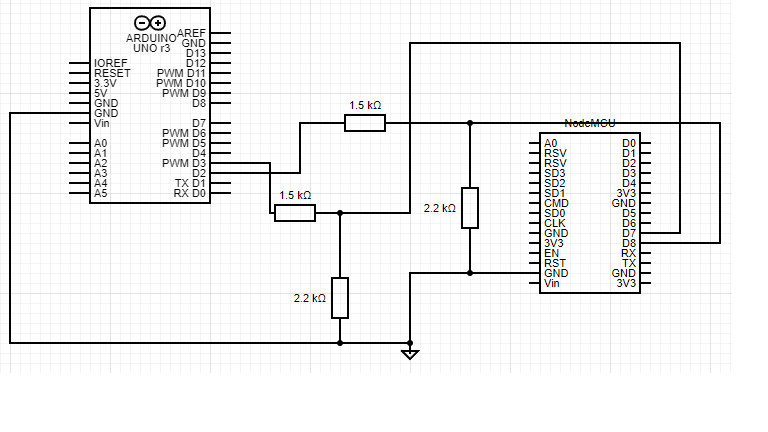Hello first time to post here. I have an issue right now I am using a mq137 sensor which requires 5v which made me use arduino uno to to make it work now I was tasked to create an app so that we can monitor it online hence using nodemcu. I connected my arduino uno and nodemcu using serial connection so that nodemcu receives the data from the arduino uno and then send it to blynk, Here comes the problem both the arduino uno and nodemcu have the same output in the serial but in the blynk app it doesn’t show the correct value.
Attached here is my code and circuit diagram:
arduino code:
#include <SoftwareSerial.h>
int gas_sensor = A0; //Sensor pin
float m = -0.263; //Slope
float b = 0.42; //Y-Intercept
float R0 = 20; //Sensor Resistance in fresh air from previous code
int relay1 = 13; // relay
int relay2 = 12; // relay
SoftwareSerial mySerial(2, 3); // RX, TX pins on Arduino Uno
void setup() {
mySerial.begin(9600); // Initialiaze SoftwareSerial communication at 9600 baud
Serial.begin(9600); // Initialize the built-in serial communication for debugging
pinMode(relay1, OUTPUT);
pinMode(relay2, OUTPUT);
digitalWrite(relay2, HIGH);
digitalWrite(relay1, HIGH);
pinMode(gas_sensor, INPUT);
}
void loop() {
float sensor_volt; //Define variable for sensor voltage
float RS_gas; //Define variable for sensor resistance
float ratio; //Define variable for ratio
float sensorValue = analogRead(gas_sensor); //Read analog values of sensor
sensor_volt = sensorValue * (5.0 / 1023.0); //Convert analog values to voltage
RS_gas = ((5.0 * 10.0) / sensor_volt) - 10; //Get value of RS in a gas
ratio = RS_gas / R0; // Get ratio RS_gas/RS_air
double ppm_log = (log10(ratio) - b) / m; //Get ppm value in linear scale according to the the ratio value
double ppm = pow(10, ppm_log); //Convert ppm value to log scale
double percentage = ppm / 10000; //Convert to percentage
String ppmString = "PPM " + String(ppm);
mySerial.println(ppmString);
// Print the sensor data to the Arduino Uno's serial monitor
Serial.print("MQ137 Sensor Data: ");
Serial.print("PPM: ");
Serial.println(ppm);
if(ppm < 2) {
digitalWrite(relay1, HIGH);
digitalWrite(relay2, HIGH);
delay(1000);
}
else if(ppm >= 2 && ppm <= 10 ) {
digitalWrite(relay2, HIGH);
digitalWrite(relay1, LOW);
delay(1000);
}
else if (ppm > 10) {
digitalWrite(relay1, HIGH);
digitalWrite(relay2, LOW);
delay(1000);
}
}
esp8266 code:
#define BLYNK_TEMPLATE_NAME "mq137"
#define BLYNK_AUTH_TOKEN "woSKw8i8qW-OG_lTWSi1rAf5wzBc-XEK"
#include <SoftwareSerial.h>
#include <ESP8266WiFi.h>
#include <BlynkSimpleEsp8266.h>
// NodeMCU pins for SoftwareSerial
SoftwareSerial mySerial(D7, D8); // RX (D7) and TX (D8) pins on NodeMCU
// Blynk authentication token and Wi-Fi credentials
char auth[] = "woSKw8i8qW-OG_lTWSi1rAf5wzBc-XEK"; // Replace with your Blynk authentication token
char ssid[] = "homewifi"; // Replace with your Wi-Fi SSID
char pass[] = "123456789"; // Replace with your Wi-Fi password
String receivedData = ""; // Initialize a String to store received data
BlynkTimer timer;
void myTimer()
{
// This function describes what will happen with each timer tick
// e.g. writing sensor value to datastream V5
Blynk.virtualWrite(V0, receivedData);
}
void setup() {
Serial.begin(9600);
delay(100);
mySerial.begin(9600);
delay(100);
Blynk.begin(auth, ssid, pass);
timer.setInterval(1000L, myTimer);
}
void loop() {
Blynk.run();
// Check if data is available on the SoftwareSerial connection
if (mySerial.available()) {
char receivedChar = mySerial.read();
receivedData += receivedChar; // Concatenate received data
// Check if a newline character is received (end of data packet)
if (receivedChar == '\n') {
Serial.print("Received Data: ");
Serial.println(receivedData); // Print the complete data packet
// Example: You can send the received data to Blynk
Blynk.virtualWrite(V0, receivedData); // Replace V0 with the desired virtual pin
// Clear the received data for the next packet
receivedData = "";
delay(500);
}
}
// Add other code or delay as needed
timer.run();
}
circuit diagram:
any help would be appreciated and thank you for reading it.
in my diagram i didn’t include the mq137 since it’s not available at Circuit Diagram Web Editor (circuit-diagram.org) but it’s connection is just 5v ground and A0(in the arduino uno)
tried to post the output but it seems that I’m not allowed yet
